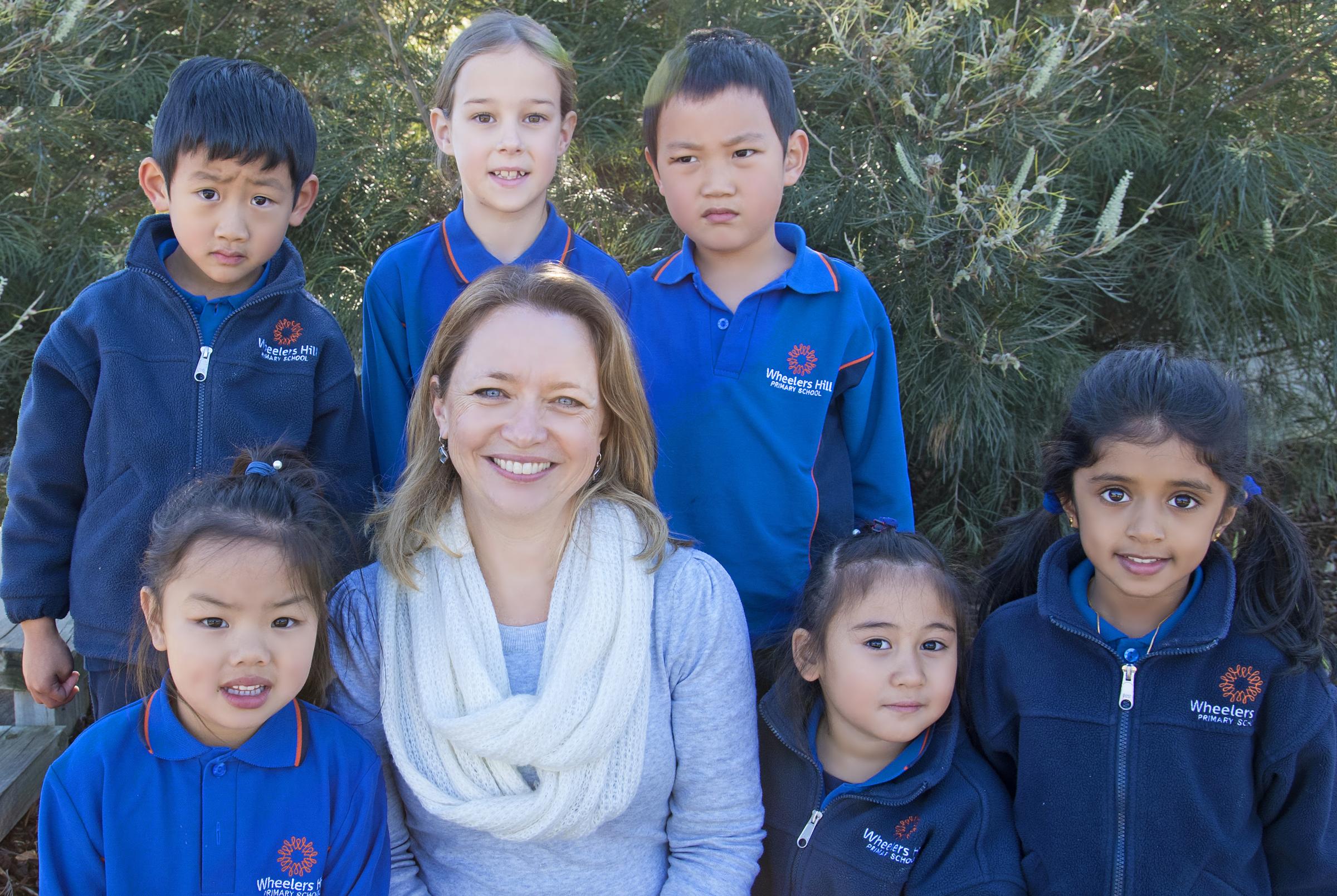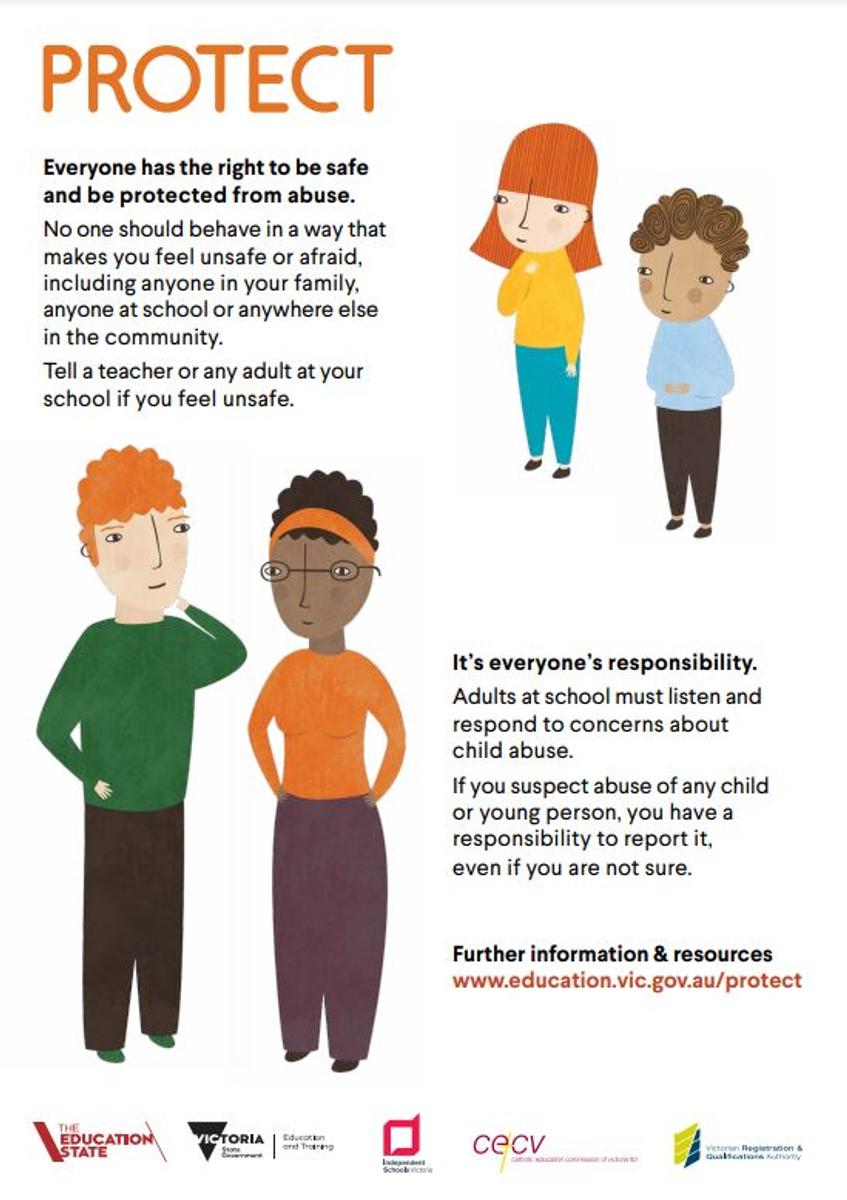Assistant Principal
Katrina Spicer - Wellbeing

Assistant Principal
Katrina Spicer - Wellbeing
CHILD SAFETY & MANDATORY REPORTING
All organisations who work with children in Australia must abide by mandatory Child Safety Standards. These standards ensure organisations have policies and processes in place to protect children from abuse.
Our school has a number of processes in place to ensure the safety of our students. Staff and School Council members receive Child Safety Standards training every twelve months and volunteers who work in our school must complete the Volunteer Induction that is available on the school's website.
All volunteers who work in our school, including parent helpers and those who go on school excursions, must provide the school with a valid Working With Children Check and must also complete the Volunteer Induction. Contractors and visiting teachers must hold a valid WWCC and complete a workplace induction.


You may have noticed this Protect Poster on display in classrooms and in various locations around the school. Ensuring our children are safe is everyone's responsibility.
All school staff undertake Mandatory Reporting training every 12 months. In this training we learn how to identify signs of child abuse, and we learn that child abuse can take on many forms including physical abuse, emotional abuse, sexual abuse and neglect. School staff members are Mandatory Reporters. This means that if a member of staff suspects a child has been abused, they MUST report this to Child Protection, even if they are not 100% sure.
At school our students are encouraged to speak to a trusted adult if they feel unsafe. Students' concerns will always be taken seriously.
If you would like further information around physical punishment of children go to the Australian Institute of Family Studies website here.
Katrina Spicer
Assistant Principal for Wellbeing and Inclusion
katrina.spicer@education.vic.gov.au


GETTING ALONG WITH SIBLINGS
Written by Dr Justin Coulson
If the sounds of “He hit me!” or “She’s hogging the TV!” are echoing though your home, you’re not alone. Sibling rivalry is as common as vegemite sandwiches in households with multiple kids. Sure, having an only child might guarantee peace and quiet, but most of us are raising a whole crew, navigating the inevitable clashes that come with it.
But here’s the thing: some squabbling is perfectly normal. It’s how kids learn to share, compromise and stand up for themselves. However, it’s crucial to know when those playful tugs-of-war cross the line into something more hurtful.
So, how do you tell the difference between everyday bickering and behaviour that needs parental intervention? Here are some questions to consider:
Is it one sided?
If one child consistently hurts, manipulates or excludes the other, it might be a sign of bullying. Look for patterns of aggression, teasing or control, especially if the targeted child isn’t instigating the conflict.
What’s the motive?
Are the children fighting over typical kid stuff like toys of attention, or is one sibling intentionally trying to hurt or humiliate the other? If the motive is malicious, it’s crucial to address the behaviour promptly.
How old are they?
Young children are still developing conflict resolution skills, so some immature behaviour is expected. However, as they grow, you can teach them healthier ways to express their emotions and resolve disputes.
If you suspect your child is bullying a sibling, here are some steps you can take:
Model respectful behaviour.
Children learn by watching their parents. Demonstrate calm and respectful communication, even when dealing with conflict.
Spend quality time with each child.
Unmet needs for attention and connection can fuel misbehaviour. Dedicate individual time to each child to strengthen your bond and make them feel secure.
Encourage perspective taking.
Perspective is the root of empathy (and empathy is the key to conflict resolution!) Ask questions like, “How do you think your sister felt when you said that?” or “What could you have done differently?” As they see the impact they have on others (and vice versa), they feel empathy and make changes that are much longer lasting than changes that are forced upon them by powerful parents.
Teach conflict resolution skills.
Equip your children with tools to resolve disagreements peacefully. This could involve teaching them to take turns, compromise, or use “I” statements to express their feelings.
Seek professional help if needed.
If the bullying persists or escalates, don’t hesitate to seek guidance from a therapist or counsellor who specialises in children’s behaviour.
Remember, some sibling conflict is normal and even healthy. It provides opportunities for children to learn important social and emotional skills. However, by addressing bullying behaviour early on and teaching healthy conflict resolution strategies, you can create a more peaceful and supportive environment for your children to thrive.


Our school subscription to Happy Families allows access to the Happy Families website to all members of our school community.
Families can access the Happy Families website at: https://schools.happyfamilies.com.au/login/whps
Password: happywhps